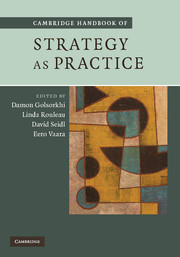Book contents
- Frontmatter
- Contents
- List of figures
- List of tables
- List of contributors
- Introduction: What is Strategy as Practice?
- PART I ONTOLOGICAL AND EPISTEMOLOGICAL QUESTIONS
- PART II THEORETICAL DIRECTIONS
- 7 Giddens, structuration theory and Strategy as Practice
- 8 An activity-theory approach to Strategy as Practice
- 9 A Bourdieusian perspective on strategizing
- 10 A Wittgensteinian perspective on strategizing
- 11 A Foucauldian perspective on strategic practice: strategy as the art of (un)folding
- 12 A narrative approach to Strategy as Practice: strategy making from texts and narratives
- PART III METHODOLOGICAL TRACKS
- PART IV APPLICATION VARIATIONS
- Author Index
- Index
11 - A Foucauldian perspective on strategic practice: strategy as the art of (un)folding
Published online by Cambridge University Press: 05 October 2012
- Frontmatter
- Contents
- List of figures
- List of tables
- List of contributors
- Introduction: What is Strategy as Practice?
- PART I ONTOLOGICAL AND EPISTEMOLOGICAL QUESTIONS
- PART II THEORETICAL DIRECTIONS
- 7 Giddens, structuration theory and Strategy as Practice
- 8 An activity-theory approach to Strategy as Practice
- 9 A Bourdieusian perspective on strategizing
- 10 A Wittgensteinian perspective on strategizing
- 11 A Foucauldian perspective on strategic practice: strategy as the art of (un)folding
- 12 A narrative approach to Strategy as Practice: strategy making from texts and narratives
- PART III METHODOLOGICAL TRACKS
- PART IV APPLICATION VARIATIONS
- Author Index
- Index
Summary
Strategic management defines itself as the art, or science, of governing an organization with the aim of implementing intentions. In this way, strategic management presents itself as an exercise of will which includes the capacity to influence, to fold or have folded, the actions of other organizational members. However, this view, which is dominant in strategic management, needs to be further examined. Like other areas of management, strategic management can be regarded as a social practice (Whittington 2002). In this sense, strategy involves routines, norms and rules that both enable and constrain the actions of the subject-strategist and limit the field of possible action (Schatzki 2001). It equally contains vocabulary, discourses and meanings that, at least partially, define the list of problems and possible solutions envisioned by the strategist (Vaara 2006).
Departing from a conception of strategy as something companies have or do not have, the Strategy as Practice approach views strategy as an activity that individuals accomplish as they interact in both a physical and social context (Whittington 2002). As a social practice, strategizing is animated by a dialectic tension between the singularity of the here and now of all activity, and the generality and recurrence of routines, norms, rules, techniques and tools on which all practice relies; between the uniqueness of the activity in the situation (that which we call the practice; Whittington 2002, p. 4) and the repetition of the sociocultural artefacts by which the strategic activity is actually realized (artefacts that are called practices; p. 4).
- Type
- Chapter
- Information
- Cambridge Handbook of Strategy as Practice , pp. 168 - 182Publisher: Cambridge University PressPrint publication year: 2010
- 8
- Cited by



